| |
"Parasocial interaction (PSI) refers to a kind of psychological relationship experienced by an audience in their mediated encounters with performers in the mass media, particularly on television and on online platforms. Viewers or listeners come to consider media personalities as friends, despite having no or limited interactions with them. PSI is described as an illusory experience, such that media audiences interact with personas (e.g., talk show hosts, celebrities, fictional characters, social media influencers) as if they are engaged in a reciprocal relationship with them." |
| |
Wikipedia* |
| |
"There is this terrifying prospect that it is actually replacing what we used to call real life. That people are developing stronger imaginary relationships with people who are themselves imaginary constructions, people who are not real." |
| |
Professor Chris Rojek Society & Culture, Brunel University |
We live, it has been frequently noted, in a celebrity culture, one in which fame of any sort is a magnet for public fascination and even obsession. And it's getting worse. TV quiz shows in which ordinary folk demonstrate their general knowledge or reasoning skills are losing ground to those in which celebrities are asked to do likewise, and even so-called reality television now prefers the famous face to that of the ordinary Jane or Joe. This is why we don't have a show titled I'm a Heathrow Baggage Handler, Get Me Out of Here! and why successful stand-up comedians no longer have to ply their original trade in order to pay for that second home.
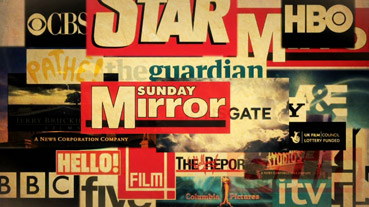
This obsession with what the rich and famous are doing has ensured that a celebrity divorce will steal headline space from news of floods or famine that have resulted in the deaths of thousands, crises that those same celebrities will then make public appeals for in an effort to be seen as humanitarians unspoilt by fame. It has even given birth to magazines whose entire raison d'être is celebrity gossip, inane title-tattle about insignificant aspects of unremarkable lives that have nonetheless built a quite phenomenal weekly circulation, and whose back issues are the scourge of medical waiting rooms everywhere.
And loathe it though you may – and I do – it's almost impossible to ignore. I actually thought I was doing pretty well, given that I don't read the gossip mags or the tabloids, watch almost no mainstream TV, and haven't seen a single minute of reality television since the early days of its satanic existence. As a result, I'd genuinely never even heard of Jade Goody until that whole Celebrity Big Brother racism story broke, but once it did there was no avoiding it, as it spilled onto the TV news and the front pages of just about every newspaper in the known galaxy. Goody was a prime example of a new type of celebrity, one who achieved fame not for her success in the arts or entertainment or some other more worthy field, but for appearing on TV in a show whole prime purpose is to create new celebrities for public consumption. The very public and often tasteless nature in which Goody's (sorry Jade's – we're all on first name terms with our celebrities) subsequent illness and death were reported, despite her apparently willing cooperation, was for me the absolute nadir of this unpleasant relationship between the media, celebrities, and the public in general.
Increasingly, it seems as if a celebrity presence is required before the mass audience will embrace even the most basic documentary information. Thus, Australia and Canada are only interesting if Billy Connolly is journeying across them, India if it's visited by funny man Paul Merton, America needs that awfully nice Stephen Fry to sell it to the more cynical Brits, and even as I write, the results of Joanna Lumley's all-expenses-paid trip to the Nile are being screened on prime time. They are, of course, standing in for us, and the reason they're able to do so is that the bond between them and their public is such that we genuinely feel that we know them. So if they receive a warm welcome in a small town in Arkansas, then we feel sure that we would too, despite the fact that they have arrived as celebrities with a production crew in tow, and their path has been carefully smoothed for them in advance behind the scenes.

Bottom line? We trust them. We don't think we do but such is the nature of that bond. It's why advertisers spend so much money hiring celebrity voices to hawk everything from toilet cleaner to home insurance. According to a American ad executive I saw interviewed some years ago now, it's not even necessary for the viewer to be able to identify the celebrity whose voice they are hearing, only to register, even at a subconscious level, its familiarity. If we recognise the voice then we unconsciously trust it. After all, these people wouldn't stiff us, would they?
Where this obsessive consumption of celebrity-related material becomes a problem, and I mean a real problem, is when it becomes a force of control, a way of shaping the news in which the celebrities appear, something the agents and PR gurus have got down to a tee. You want access to their clients? Then make sure you say nice things about them, preferably the stuff that's been provided for you in the press releases. Start questioning their integrity or asking difficult questions and you'll be permanently out of the loop.
It's this infatuation with celebrity and its effect on the way in which news is reported that is central to Starsuckers, Chris Atkins' suggestively titled and consistently fascinating documentary exposé. Although adopting a standard investigative format, the film is satirical in its approach, presenting its case from the viewpoint of the manipulators, like an information film made a tobacco company designed to educate its affiliates on the best ways to get kids hooked on their product, complete with step-by-step instructions, title cards, animated inserts, and an enthusiastically upbeat American voice-over. It's a technique that risks coming across as self-satisfied and manipulative, putting words into the mouths of the perpetrators that have obviously come from the enemy camp, so to speak. But given the manner in which information is manipulated by the media figures that Atkins targets, it seems only appropriate that he returns fire in likewise fashion, and he backs up his arguments with a wealth of expert testimony on everything from the nature of celebrity addiction to the rise in narcissism in western society. He even charts the evolution of our attraction to fame from the dawn of man to the present day, and provides a biological breakdown of the brain activity that leads to this condition.

Chaptered around a set of five basic ground rules – Start Them Young, Keep Them Hooked, Hard Wired Urges, Gathering Information, and Creating News – the film covers a lot of ground and illustrates the points made with specific and well-chosen examples. Perhaps the most bemusing of these, at least for this particular UK viewer, is 5-year-old rising American celebrity Riyann, who poses for photos, does guest spots on radio shows, and whips up a crowd at a rock concert, but whose fame seems to stem from nothing more than his ability to act confident and dress like an 1980s rapper. The few industry insiders who do talk to the team are surprisingly open about the tricks of their trade. A London-based paparazzi known as Kev the Pap explains how the timing of a photograph can allow headline writers to twist a story to suit their needs, while wide-boy PR man Dave Read reveals how he fabricates seemingly negative stories to get his clients' names and faces into the news. He even ropes in members of the film crew to play placard-waving demonstrators in order to secure wannabe beauty queen Casey Bachelor the very newspaper space she has doubtless paid him to engineer.
Particularly revealing are the stunts Atkins pulls to expose the shallow nature of fame and the slapdash manner in which celebrity news is reported. In the film's opening scene he triggers instant public fascination by having a bevy of photographers pursue two non-celebrities into a hotel, and later convinces a stream of eager parents to audition their children for fake TV reality shows titled 'Baby Boozers' and 'Take Your Daughter to the Slaughter House'. His team even feed false stories to newspapers that are gobbled up and printed without a word being checked, and off-record conversations with eager young gossip journos and superficial PR guru Max Clifford are captured on hidden cameras – Clifford's revelations are outrageous enough to require the cautionary bleeping of the names of those involved.
Where the film is most likely to divide its audience is its questioning of the effectiveness of charity concerts like Live Aid and Live 08. That events such as these boost the profile and album sales of the participants will come as no surprise, but the suggestion that the aid distribution may have resulted in the loss of more lives than were theoretically saved is likely to raise a few eyebrows. The reasoning behind the argument, as put by World Policy Institute Humanitarian Aid Expert David Rieff, certainly seems credible, but would have carried a bit more weight if a second or third source had been produced to back up his claims.
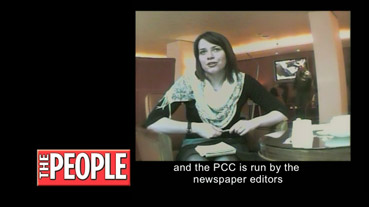
For the most part, however, Starsuckers presents a comprehensive and troubling case that is likely to hold some surprises for even the most cynical and celebrity-indifferent viewer. Where it really hits gold is in making even those of us who actively resist the allure of fame and star power aware of just how complicit we are in the process. For that alone it needs to be as widely seen as possible, to be shown in schools and colleges and on prime time TV, not tucked away late at night on More 4 as it was on its first television screening last week. Whether the message actually gets through is another matter – as the credits rolled on its More 4 screening, they were pushed aside so that some infuriatingly cheerful announcer could tell us, without a hint of irony, about an upcoming show whose key appeal was that it would feature "a host of celebrities." I have little doubt that Atkins was left shaking his head in disbelief.
Shot on HD on what looks like a mixture of pro and semi-pro cameras, the interview footage is crisp with well balanced contrast and colour, but is inevitably mixed with material from a variety of other sources, including covertly shot DV and extracts from TV programmes that have not all been sourced from the original tape or digital masters. I can't think why. On the whole, though, this is a very fine transfer. The framing is 1.78:1 and the picture is anamorphically enhanced.
Both Dolby 2.0 stereo and Dolby 5.1 surround tracks have been included, but I'm not really sure why given the nature of the film, which has no need of directional effects or the all-enclosed feel that the surround stage can provide. The main difference is that the narration and interview voices are located front and centre on the 5.1 and spread across the front stage on the 2.0. The music is the main user of the stereo effects.
There are no subtitles included.
Commentary
The first thing you need to know is that you won't find the commentary in the Bonus Features section but in the Audio Setup menu, which I didn't go to until I'd watched the film and every other feature on the disc. Some may wonder about the value of a commentary on a documentary, but I can't imagine anyone watching this film would not have a few questions about the hows and whys of particular scenes, and writer-director Chris Atkins and producer Christina Slater are happy to answer them, with any ground not covered here dealt with in the making-of documentary detailed below. It's an unsurprisingly busy affair in which Atkins and Slater recall the shooting of specific scenes, their reasons for doing things the way they did, and how they approached aspects like the faking of news stories or the mock reality TV auditions. The background they provide also enhances your appreciation of some sequences, though the very general discussion about the Live Aid section, while interesting, doesn't quite provide the evidential boost it needs. Very good stuff on the whole, however.
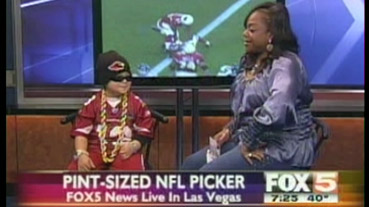
The rest of the extras are in the Bonus Features section, but don't be fooled by the list you first encounter, as the first few have subsections, and one of those subsections also has a subsection.
The Media has six subheadings, one of which... oh we'll get to that in a minute. They are as follows:
Kids Talking About the Media (2:31)
Kids from a number of schools talk about how watching TV, celebrity magazines, and the way stories are manipulated by the press.
Entertainment Journalist (4:03)
An unidentified entertainment journalist (his face is kept in shadow) provides the low-down on the facile and manipulative nature of celebrity journalism, including a short anecdote about the consequences of not playing ball. He nicely describes arts journalism as "interviewing posher celebrities" and the Hollywood paparazzi as psychopaths with cameras.
Paparazzi is subdivided into four featurettes.
Kids Talking About Paparazzi (0:52)
Some of the same kids from above state the obvious about one of the negative aspects of fame.
More Kev the Pap (5:43)
Kev the Pap plays high speed cat-and-mouse with a fleeing actress's car and has to settle for snapping a a blizzard of shots blindly through a window and be driven away hurriedly by the flustered Atkins. At one point he gets into a stand-up fight with an objector, an incendiary moment that features some very strong language.
Owen the Pap (4:23)
Another paparazzi talks about stalking Britney Spears, the more disreputable members of his profession, and Hollywood as a celebrity factory. Also included is a sneaky bit of footage, "accidentally" grabbed while the crew were setting up, in which Owen reveals quite a bit about the mercenary and manipulative nature of his job.
Paps Chase Britney (2:49)
Atkins joins about fifty paparazzi who are stalking Britney Spears and continue to ply their trade even as they are being firmly dissuaded by the police.
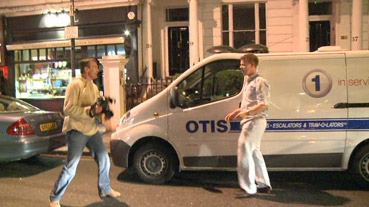
Media's Influence on Mass Shootings (7:31)
A small and complete report in its own right about how shooting sprees may be fuelled by the manner in which such incidents are reported. It's an angle you may well be familiar with – commentators as diverse as Michael Moore and Charlie Brooker have made similar observations – but the case is very concisely put here.
Celebrities has seven small featurettes.
Kids Talk About Fame (3:01)
The kids from above talk about why they'd like to be famous. Not too many surprises here.
Famous People!!! – Celebrities on Celebrities (8:24)
Another fully scored and edited piece in which Atkins and his crew talk to a number of celebrities about fame after sneaking into film premieres under false pretences. Those nabbed include Keira Knightley, Clint Eastwood, Georgie Henley, Samuel L. Jackson, Curtis "50 Cent" Jackson, Emma Watson, Chris North, Al Pacino, Robert De Niro, William Moseley, Eddie Izzard, Ralph Fiennes and Jennifer Tilly, the most up-front and self-aware about the effects of fame of anyone here.
Oliver Auditions Celebrity Kids (2:17)
Interviews with kids and their parents at the auditions for the BBC reality show I'd Do Anything, the sort of programme the filmmakers state up front that they regard as harmful.
Liliana Dalla Piana – Celebrity P.A. (2:35)
The PA of the title talks honestly but a little guardedly about the nature of her job.
Luke Yankee – Celebrity Son (3:17)
The son of Oscar-winning actress Eileen Eckhart cleans his mother's star on the Hollywood Walk of Fame and discusses the experience of having a famous mother.
Ian Drury – Celebrity Publisher (2:51)
Ian Drury (not the Ian Drury whose music I grew up with, I should note) provides an informative breakdown of the celebrity biography market, the work of ghost writers and celebrity branding.
Gifting Suite – Celebrity Ligging (4:33)
Marketing man Mark Harris cheerfully takes us through the process and purpose of "gifting," and the good people from Nephria soaps reveal the advantages of having a celebrity name attached to your product.
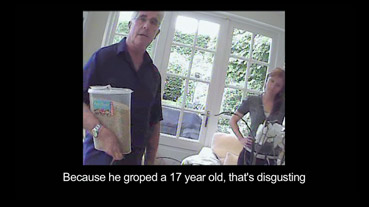
Fans has two inclusions.
Kids Talk About Their Idols (3:04)
Not too many surprises here, though I was caught out by the schoolgirl who chooses Barbara Windsor as her favourite celebrity, and another girl tells a story that relates directly to the aspirations of the Nephria reps above. Top marks, though, to the boy who reveals that his role model is his mum for keeping strong through difficult times. I'm with you, kid.
Morrissey Fans (3:32)
Atkins and the team meet a group of Morrissey devotees, who proceed to re-affirm the claims made by the film about the parasocial relationship between celebrities and their fans. One even describes it as being like a religious experience, another suggests that she found Morrissey through prayer, and a third warns Atkins in all sincerity that if the film says anything negative about Morrissey he'll hunt him down and kill him. What a tit. I don't actually believe this to be true, but in the hope of winding up this particular idiot I'd like to state publicly that Morrissey is bollocks. Do your fucking worst, quiff boy.
Celebrity Charity has four featurettes.
Kids Talk About Celebrities and Charity (2:34)
The general opinion here is that celebs have too much money and should give more away, and several of the kids seem very aware of the more self-serving reasons for celebrity charity work.
Brendan O'Neil (3:33)
The editor of the refreshingly cynical Spiked magazine talks about celebrity colonialism, concert campaigns like Live Aid and Live 8, and the negative effect of celebrity involvement in international politics.
Toyota Charity Event (2:43)
Celebrities drive really fast round a track for a charity called "Racing for Kids" and get a bucket of free promotion in the process. Atkins interviews a few and even takes the piss out of one pair for taking "a whole two hours out of their day" to visit sick children in hospital, seemingly without them realising he's doing so.
Alexander Nicholas (2:06)
The founder, publisher and editor-in-chief of Hollywood Hills magazine discusses celebrities and their charities and the use of causes for self-publicity.
The rest of the extras listed have no subsections.
Making of Documentary (35:25)
A fine retrospective making-of documentary that compliments rather than recycles points made in the commentary. Writer-director Atkins, producers Christina Slater and Felicity Leadbetter, co-producer Victoria Hollingsworth and production lawyer Simon Goldberg takes us on a fascinating trip through key aspects of the film's production, outlining how it first came about and covering in some detail the chaos of filming in the US, working with Riyann, Kev the Pap and Dave Read, a trip to Cannes that has put Atkins off the place for life, getting the hidden camera footage, planting the fake stories, and the litigious responses of Max Clifford and The News of the World, both of whom tried to use laws they have for years been campaigning against to shut the film down. As with the DVD of Marc Singer's Dark Days, the story of the production is almost as fascinating as the film itself.
Trailer (2:42)
A very seductive sell that includes a brief snatch of that fight with Kev the Pap which is not in the film itself.
Promo Animation (2:11)
Another, slightly more ambiguous, but still rather neat sell for the film.
A fascinating, thoroughly researched and important wake-up call that needs to be seen and shown and acted upon. Even if you saw the film on its More 4 screening I'd thoroughly recommend Network's DVD, for its better-than-broadcast picture quality, for the absence of that infuriating (and plasma burning) channel logo, for being allowed to watch the end credits without some upbeat idiot babbling on about celebrities, and for a wealth of extra features that really do enhance and expand on the film. Buy it, watch it and do what you can to question and even upset the status quo.
|